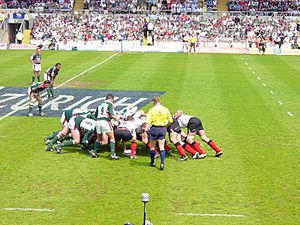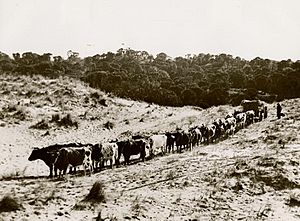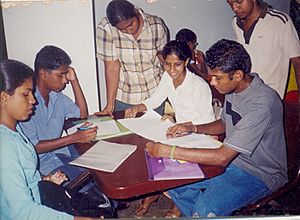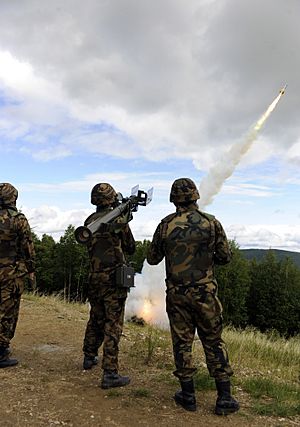Team facts for kids
A team is a group of people who work together to reach a common goal. Think of a sports team trying to win a game, or a group of friends planning a fun event.
Teams are special because their members often have different skills. When they work together, they create something bigger and better than what each person could do alone. This is called synergy. It means that the team's total effort is more powerful than just adding up what each person does by themselves.
As one expert, Naresh Jain, said, "Team members need to learn how to help one another, help other team members realize their true potential, and create an environment that allows everyone to go beyond their limitations." This means teamwork helps everyone grow!
Many people believe that working in teams is very effective. It can help people achieve more and even feel happier and grow as individuals. Teams can meet in person or online, using technology to communicate. Good communication is super important for a team to succeed!
A team becomes more than just a bunch of people when everyone feels strongly committed to the same goal. This strong commitment helps them achieve amazing things together.
For example, a team of game players works together to win. Or, in the past, people used teams of horses or oxen to pull wagons and move goods.
Contents
Types of Teams
There are many different kinds of teams, depending on what they do. Some teams gather information, while others actively perform tasks.
Teams by What They Do
Action Teams
An action team is a group of people with strong leadership skills. They come up with plans, look at different situations, and then carry out the actions needed.
Advisory Teams
Advisory teams give suggestions about a final product or plan. For example, a quality-control team in a factory might check products and suggest ways to make them better. They are experts who help make sure things are just right before they are sold.
Command Teams
Command teams help share instructions and organize actions between different groups. They act like a "middle person," passing messages. For instance, messengers on a construction site might tell builders what the executive team wants them to do.
Executive Teams
An executive team is a management group that creates plans for activities. Then, they guide these activities to make sure they happen. An example is a construction team designing blueprints for a new building and then overseeing its construction.
Project Teams
A project team is formed for a specific job that has a clear end date. These teams are often made up of people with different skills and knowledge. They might come from different departments but work together on the same project. Once the project is done, the team usually breaks up.
Project teams are special because they focus on making things happen. They have a clear:
- Time: A set deadline or period to complete the task.
- Task: A unique job that no one else is doing in the same way.
- Team: The people who will do the work in the time given.
- Transition: A clear result or change expected after the project is finished.
Sports Teams

A sports team is a group of people who play sports together. This includes all the players, even those waiting to play, and support staff like a coach. They work together to win games.
Virtual Teams
Thanks to technology, many teams now work virtually. A virtual team is a group of people who work together from different places, at different times, using technology like computers and the internet to communicate. They might be across a country or even the world! They often solve problems or create new ways of working.
Work Teams
Work teams are responsible for actually creating tangible products or services. For example, the workers on an assembly line who build cars are a production team. Waiters and waitresses at a restaurant are a service team.
Teams by How Members Work Together
Teams can also be described by how much their members depend on each other.
Interdependent Teams
In an interdependent team, members rely heavily on each other. No big task can be done without everyone's help. Each person often has a different special role, and the success of one person is tied to the success of the whole team.
A rugby team is a great example. No matter how good one player is, they can't win the game alone. Everyone needs to work together.
Independent Teams
In an independent team, members mostly do their own work. What one person does usually doesn't directly affect the performance of the next person.
A track-and-field team is an example. Runners win their own races. While teammates can offer support or advice, each person's success comes from their own effort. In a business, sales teams are often independent teams, as each salesperson makes their own calls.
Coaching Differences
Coaching an interdependent team (like a football team) is different from coaching an independent team (like a gymnastics team). Interdependent teams benefit from members getting to know each other and building trust. They do well with rewards for the whole team. Independent teams often perform better with individual rewards.
Multidisciplinary and Interdisciplinary Teams
In fields like medicine, teams can be multidisciplinary or interdisciplinary.
- Multidisciplinary teams have several experts who treat different issues a patient might have, each focusing on their own specialty.
- Interdisciplinary teams work together towards the same goal. Members might even take on tasks usually done by someone in a different role to help the team succeed.
Self-Directing Teams
These teams have the most freedom. The team members decide their own goals and how to reach them. Management's main job is to create a good environment for the team. Self-directing teams can be very creative and motivated.
Team Size and Makeup
The best size for a team depends on the job. Some studies suggest that four members is a good size for problem-solving. Others say between 5 to 12 members, or "a number of members that can consume two pizzas."

Teams usually have a mix of people. If everyone is too similar, the team might be very close, but they might not have many new ideas. If the team has many different types of people, there can be more creativity, but also more chances for disagreements.
Team members often have different roles, like a team leader and other members. Large teams might even split into smaller sub-teams.
Many teams go through stages as they develop:
- Forming: The team first comes together.
- Storming: Members might have conflicts as they figure things out.
- Norming: The team starts to work through conflicts and agree on how to work.
- Performing: The team works well together and focuses on its goals.
- Adjourning: The team finishes its task and breaks up.
How Teams Think Together
Team cognition is about how a team's knowledge is organized and shared among its members. It's like the team having a shared brain. This helps teams work better because they understand the situation and their goals in a similar way. They also know who on the team has certain knowledge, so they can easily find the information they need.
Making Teams Effective
Just putting people into teams doesn't automatically solve problems. Teams work best for tasks that are difficult, complex, and important – jobs that are too big for one person.
For a team to be successful, they need training on how to work together. Teamwork can be challenging, even for talented individuals. They need to learn to coordinate their actions and get along. Organizations also need to support their teams fully. For example, a car manufacturing plant called NUMMI became very productive and made high-quality cars by creating a new team structure where management strongly supported the workers.
Not All Groups Are Teams
Sometimes people use the word "team" when they really mean "employees." For example, a "sales team" might just be a group of salespeople who work individually. While they are part of the same company, they might not truly work as a team.
A working group's performance is just the sum of what each person does. A true team's performance is made up of both individual results and collective results. Teams create things together, and this makes their total performance greater than if each person just did their best work alone. A team is truly more than the sum of its parts!
Team Leadership
In a team, leadership is often shared. Each member takes on some responsibility and helps others see their strengths.
First, the team needs to see themselves as a team, not just a group. Second, the team sets clear goals. The leader helps the team make decisions and agree on how to reach those goals. Third, the team decides what actions to take. This might involve improving how they work together, getting training, or getting support from others. Finally, the team's leader helps find ways to make teamwork even better. They might ask for feedback to solve problems or find new ways to improve. A strong team always tries to get better and is open to help.
It's a myth that teams need one super strong and powerful leader who controls everything. Leaders who try to do everything themselves often end up overworked and less productive.
Instead, teams need leaders who can inspire and guide them. These leaders:
- Inspire Others: They lead by example, and people like how they do things and treat others.
- Motivate: They share a vision that inspires others to achieve things they thought were impossible.
- Encourage Thinking: They encourage team members to be creative and challenge old ideas.
- Care for Individuals: They truly get to know each team member, helping them reach their full potential.
These kinds of leaders help teams bring out everyone's best ideas and strengths, leading to great success.
See also
 In Spanish: Equipo para niños
In Spanish: Equipo para niños
- Coalition
- Community
- Driving (horse)
- Forming-storming-norming-performing
- Group (sociology)
- Groups of people
- Judge–advisor system
- Multiteam system
- Player
- Super-team
- Team Action Management
- Team building
- Team composition
- Team management
- Teamwork
- The Five Dysfunctions of a Team



